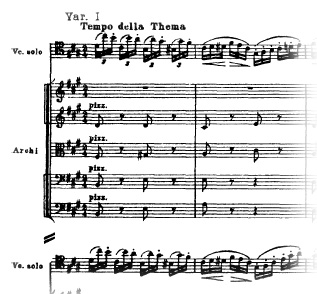Tchaikovsky composed the Variations on a Rococo Theme in December of 1876, amidst the turmoil of a failed opera production in St. Petersburg and a particularly nasty review in Vienna from the feared critic Eduard Hanslick. Prone to insecurity even at the best of times, Tchaikovsky asked for advice from the new work’s intended cello soloist, Wilhelm Fitzenhagen. Just 28, Fitzenhagen was a professor at the Moscow Conservatory and principal cellist for the Imperial Russian Music Society. He also fancied himself a composer, and his “corrections” to the work of his well-established colleague show surprising aplomb. Fitzenhagen rearranged the order of the variations,
removing one entirely, and rewrote most of the solo part. Tchaikovsky accepted the changes, and the hybridized version entered the popular canon, thanks to Fitzenhagen’s numerous concert appearances and an 1889 publication. 20th-century scholarship (aided by X-rays) revealed Tchaikovsky’s original music under Fitzenhagen’s emendations, and a reconstructed version debuted in Moscow in 1941. By then, Fitzenhagen’s edition had cemented its reputation among cellists and audiences, and it continues to be the customary choice for performances.
The Variations on a Rococo Theme reference the 18th Century — especially Mozart, whom Tchaikovsky adored. The theme is Tchaikovsky’s own invention, and it has little relation to the ornate Rococo style that emerged in France under Louis XIV, a movement that produced gilded palaces and the trill-happy music of Couperin. Following a stately orchestral introduction, the cello introduces the light-stepping “rococo” theme, balanced into two repeated sections. The theme ends with a harmonically adventurous codetta, first in the winds alone and then shifting to the strings. That material returns various times to link the connected variations, and it brings Tchaikovsky’s rich Romantic voice into dialogue with the lean Classical ideals explored elsewhere in the work.
The first two variations maintain the theme’s flavor and pulse, adding increasing decoration and commentary. The third variation breaks away to a singing melody, one of those heartbreaking tunes that Tchaikovsky unfurled with such ease. The fourth and fifth variations return to an outgoing, virtuosic character, culminating in an extended cadenza. The sixth variation, a minor-key andante, bookends the earlier slow section, and trails off in an ascent of ethereal harmonics. The final variation follows the work’s only pause, and enters with a rustic, throbbing intensity. It intensifies through quick call-and-response phrases and breathless figurations, linking directly to the energetic coda and a rousing conclusion.
Copyright © Aaron Grad 2011
Variations on a Rococo Theme
Op. 33
Composed in 1877
By Pyotr Ilyich Tchaikovsky







Thanks very much!